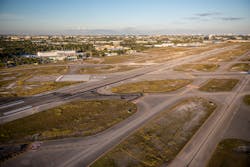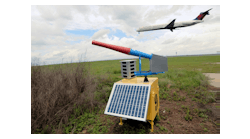As airports across the U.S. continue to expand and renovate, protecting environmental resources is often one of the top priorities for stakeholders and communities. To successfully and responsibly deliver needed aviation projects, airports need the right environmental processes and expertise — and sometimes a little bit of creativity.
When Fort Lauderdale Executive Airport (FXE) needed to build a new loop road to improve vehicle access, it faced a challenge unique to its area. Florida burrowing owls and gopher tortoises had taken up residence on the airfield, requiring experts to find the protected species and safely relocate them, while navigating tight timelines, cold weather and a strict Florida Fish and Wildlife Conservation Commission permitting process.
The challenge is a familiar one to Florida airports, which have employed various methods to work around protected species, from repeated relocation to more suitable areas, to installing artificial turf to dissuade new residents. Gopher tortoises in particular, whose populations are threatened throughout Florida, are protected by strict regulations that protect them and their underground burrows, and which makes handling the animals illegal without a license.
FXE Airport Manager Rufus James said working around these animals in an environmentally responsible manner has been a consideration since he began his role at the airport 20 years ago.
“As challenging as it is,” James said, “we’ve always teamed up with the right professionals, which makes the task at hand easy to handle and makes it a success.”
In Fort Lauderdale, a proposed loop road on the west end of the airport was one of two designed to reduce runway incursions by allowing fuel trucks and tugs to reach their destinations by going around the runway rather than across it. Successfully mitigating impacts to the owls and tortoises was critical to a successful project delivery effort that encompassed the full project development process, from design, to environmental clearance, through construction. It’s one of many projects on which HDR has partnered with FXE Airport Engineer Fernando Blanco as the airport’s general engineering aviation consultant. A south loop road completed in fall 2018, also by HDR, similarly had to work around these species; although to a lesser extent.
“When we did the south loop road the number of burrows were minimal, maybe one or two,” James said. “But with the west end, the numbers were in the double digits, so it called for a different approach—relocating animals to a new area.”
To accommodate the west loop road, however, HDR helped the airport move 20 gopher tortoises to a new home and created new starter burrows for Florida burrowing owls—protecting them outside of the project area.
A Complex Headcount
Florida burrowing owls and gopher tortoises love the grassy open land and sandy soils found in areas such as FXE and the airport has long protected the animals by marking known burrows so maintenance workers and landscapers can avoid disturbing them. The work began in summer 2017 with a survey of animals in the project area. However, a formal survey was tricky, in part because gopher tortoises and burrowing owls were found to swap burrows, and in one instance, to share burrows at the site.
Determining which animals were using which homes was key, because there are different rules and permits for each species and burrow. Knowing Florida’s permitting process, and what is required by the state to protect each species, was critical.
Sherri Swanson, a senior environmental scientist for HDR, and a certified Gopher Tortoise Agent, was brought in to survey the project area. Her preliminary work identified the potentially occupied, active, and inactive burrows in the path of the proposed construction.
After the initial survey was completed, Swanson led the process of applying for permits – which allowed the team to collapse unoccupied owl burrows and to relocate gopher tortoises found in the affected area.
A year later, permits now in hand, the area was resurveyed. Seventeen owl burrows and more than two dozen tortoise burrows were mapped in the area in October 2018. Knowing what to expect, the team was now ready to relocate the animals, but the clock was ticking.
Looming Deadlines
Strict regulations govern any disturbance of either species, including rules that determine the timing of any action.
Gopher tortoises cannot be moved if conditions at their recipient site are forecast below 50 degrees for three consecutive days after the tortoises arrive. With late fall and winter weather approaching, the team had to thread a needle on temperature and timing. Cold weather was a concern, as the tortoises were to be relocated to a site about 500 miles northwest, to an area much cooler than at FXE. Making sure tortoises made it to the new site while suitable temperatures held was critical to ensuring the construction project could be completed without delay.
Further complicating the work, burrowing owls cannot be disturbed during nesting season, which typically starts Feb. 15 (but can sometimes begin earlier) and ends July 10 each year. If the team missed the window before temperatures fell too low, they would have had to wait until owl nesting season wrapped up the next summer — delaying construction. That would also have meant securing new permits and potentially causing additional delay and money.
In early November, the gopher tortoise burrows were checked with a camera scope before being slowly and methodically dug from the opening to the end chamber with the help of a certified backhoe excavator to ensure the burrow was empty or that the gopher tortoise was safely captured. Some of the digging was done by hand to make the process as safe as possible for the tortoises. Because gopher tortoise burrows can be 10 or more feet deep and up to 30 feet long, it was a two-day process, from sunrise to sunset, of slow digging to ensure no harm came to the animals. Altogether, 31 burrows were excavated, and 20 tortoises, ranging from less than 2 ounces to more than 17 pounds, were respectfully captured and relocated.
Once the tortoises were captured they were transported to the Apalachicola National Forest Research Recipient Site, about 500 miles northwest. HDR coordinated directly with the recipient site manager and the Florida Fish and Wildlife Conservation Commission to ensure the relocation transport went smoothly and the tortoise adjusted to their new home.
Swanson and HDR engineer Ryan Beckman also rechecked each owl burrow in the project area, and three of the burrows were checked one more time with a camera scope. Once it was confirmed the burrows were unoccupied, they were excavated by hand and collapsed. Six others nearby were staked and protected, and all others outside the disturbance area were protected with barrier fencing. Knowing some owls could potentially lose their homes, the team dug nine new starter owl burrows (away from the project area) for the airfield’s winged residents to move into.
To confirm their success, the team made return visits. In early December evidence of activity at the starter burrows could already be seen, and by February two of the burrows were confirmed to be occupied (possibly by a nesting owl pair) and three others were potentially occupied.
‘Just Good Business’
With animals safely out of the way, construction on the loop road was able to take place without worry about impacts to the animals and without delay to the construction schedule because of the inadvertent discovery of a threatened species. It was completed in mid-spring.
Taking care of the animals was part of a longstanding emphasis on environmental stewardship by the airport. “Environmental sustainability is just good business,” said James. “We’re a very busy airport, but we’re not so busy that we overlook the protection of wildlife around the airport.”
James noted that wildlife preservation has long been important to the community. The city of Fort Lauderdale, which owns the airport, has been certified as a Community Wildlife Habitat by the National Wildlife Foundation—recognizing the community’s commitment to restoring habitat and coexisting with wildlife.
The animal relocation operation will almost certainly not be the last for FXE. The effort came amid ongoing improvements and expansion at the airport, which is also planning a runway extension, and a number of additional taxiway improvements. As the airport continues to grow, those projects will also have to take into account the wildlife that use the wide open green spaces found on the airfield; again dealing with strict state regulations that protect the animals and limit the timing windows for construction work.
“We’re fully aware of the fact that burrowing owls have a mating season and the gopher tortoises can’t be touched in their burrows,” James said.
Other airports in the Southeast will face the similar challenges. But good planning, expert assistance, and a creative solution can mean a successful project without surprises, except perhaps for the owls and tortoises who end up in new digs.
Sherri Swanson is a senior environmental scientist and project manager for HDR who has provided wildlife expertise throughout the U.S. for airports, utilities, roadways, solar fields and more.
Ryan Beckman is an aviation designer for HDR who has worked on multiple airport projects throughout Florida and beyond.



